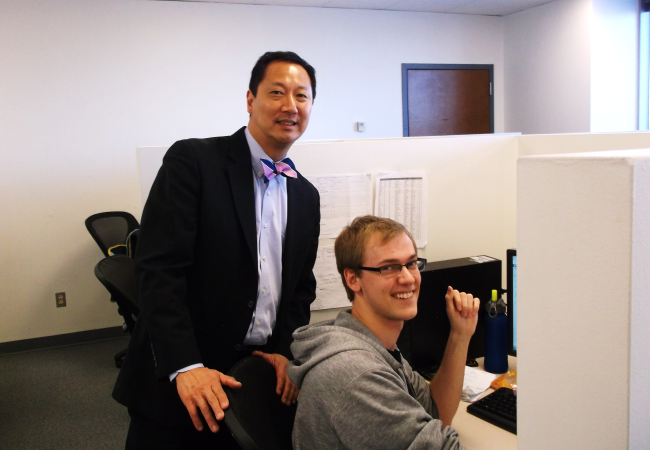You have /5 articles left.
Sign up for a free account or log in.

University of Cincinnati President Santa Ono and student Connor Fitzpatric in the Cincinnati Insurance Company testing center
The University of Cincinnati
On Tuesdays and Thursdays, Connor Fitzpatric went to work -- but only until noon. His first class began at 12:15 p.m. After class, he would go back to work for a couple of hours, until 5:30 p.m., and then it was back to class until 9 p.m.
His commute was only a few minutes. As he went back and forth between class and work, he never left campus.
He worked in an on-campus space leased by his employer, a local insurance company. The company designed the space -- and the internship itself -- specifically for students balancing jobs and class work. Fitzpatric designed his own schedule, and he was allowed to change it. If, say, a paper deadline loomed on the horizon, class work took precedence.
“If an exam came up, there's no problem,” said Fitzpatric, a student at the University of Cincinnati. “It wasn't, ‘Oh, you're scheduled to work.’”
In fact, Fitzpatric and his fellow interns at Cincinnati Insurance were encouraged to eschew traditional work hours. They work when they have free time -- in the evenings after class, in the mornings before class, in gaps of time in the middle of their days -- without ever leaving campus.
The idea is to work with the needs of college students, who may have trouble keeping regular hours or commuting long distances. “It’s difficult for a college student to get in a car and drive 10, 15 miles to a work location,” said John Kellington, CIO of Cincinnati Insurance.
Cincinnati Insurance is located 15 miles from the university. Fifteen miles wouldn’t be far for a commute to a full-time job. But for college students, many of whom lack cars, 15 miles is a long way.
Consider the reasons a college student wouldn’t accept a job 15 miles away: she would need a long block of time, uninterrupted by her class schedule. She would need to factor in the time to commute to and from campus. She would need a car, or a generous friend with a car or a city with a robust public transportation system.
Cincinnati Insurance’s solution costs more up front, but company leaders say it works: when you’re working with 19- to 22-year-olds, and you bring the work to them, they show up.
‘Just Walk Across Campus’
Cincinnati Insurance hasn't just pursued this strategy out of the goodness of its heart, or to give students flexible jobs. When it opened its on-campus location, Cincinnati Insurance was having trouble recruiting. It wanted a steady supply of motivated, professional workers, and it hoped to capitalize on the nearby student population. And maybe, eventually, those students would become full-time employees.
But first, the company needed to get the students in the door, Kellington said. And that’s when he realized: “It’s a lot easier if they can just walk across campus.”
The first 20 interns started in the spring of 2015. And slots were competitive: Brian Wood, head of the company’s human resources department, doesn’t remember how many students initially applied -- but he estimates that the company narrowed the original applicant pool down to a group of 45 or 50.
During the summer, interns train full time at the company’s headquarters. During the academic year, they work at the on-campus center, usually for about 20 hours a week. While deadlines are firm, hours are not: students work when they don’t have class, putting in a couple of hours here and there.
Everybody wins, company leaders say: students get work experience, flexibility and $11 an hour. Cincinnati Insurance gets access to a steady source of reliable, talented workers early on in their careers, before they’re lured away by other companies.
“There's a real competition to secure skilled talent coming out of our universities,” said University of Cincinnati President Santa Ono, who recently stepped down from his position. “They came to us saying, ‘How can we get more of your students?’”
The goal is to prime students for full-time jobs -- and the program acts as a months-long trial period. By the end, company leaders say they have a clear picture of each student’s work ethic and performance. “Those are things that don't necessarily come through in an interview or on a résumé,” Wood said.
Of the first group of students, the company hired five or six. Fitzpatric was one of them. He hasn’t yet graduated -- he’ll be taking night classes -- but he started at the company full time in March.
A Low-Cost Resource
As higher education budgets tighten and pressure to keep tuition low grows, other sources of funding -- like federal grants -- aren’t increasing to meet demand. Partnerships with nearby businesses are a financial strategy, Ono said. “There's got to be some way to address the delta between resources coming in and actually growing.”
In all of the university’s corporate partnerships, the costs always fall to the companies. They pay to lease space near campus, and they pay to convert those spaces into labs or workstations. In return, the companies get access to student workers -- and they often retain intellectual property rights.
A block and a half away from campus, another group of students works in a row house funded by Procter and Gamble. Called the Simulation Center, it operates much like Cincinnati Insurance’s on-campus location. Students work part time, and they don’t have regular hours. They come and go when they have time between classes.
“Students are given a lot of freedom in when they want to work and what they want to work on,” said Teik Lim, dean of the university’s College of Engineering and Applied Science. “It’s almost like working in some of the Silicon Valley companies.”
At both Procter and Gamble and Cincinnati Insurance, employees are assigned as go-betweens for the students and the company. They don’t operate as traditional bosses; instead, they check in on the students, help train them and report back to headquarters.
Students at the Innovation Center work on creating models and simulations as faster, cheaper alternatives to physical experiments. Due to the nature of the work, they are typically studying fields like engineering, computer science, chemistry, biology or design.
While the Cincinnati Insurance students spend their internships working on IT testing, the company picks from across all majors. And while some of the students they hired -- like Fitzpatric -- are working in IT roles, others are working in business-related positions.
“They're cultivating students for underwriting roles, HR roles, finance roles,” said Paula Harper, manager of job development in the university’s Academic Internships Program.
But the internships don’t need to be a pathway to full-time work, Harper added. Often, students romanticize their career choices. If they’re able to work in their chosen field during their time on campus, they can learn early on whether they’re really interested in a given career path.
“Sometimes students create a fantasy about what a particular type of position is going to be like,” she said. “Getting experience while they're still in school helps them to course correct.”




